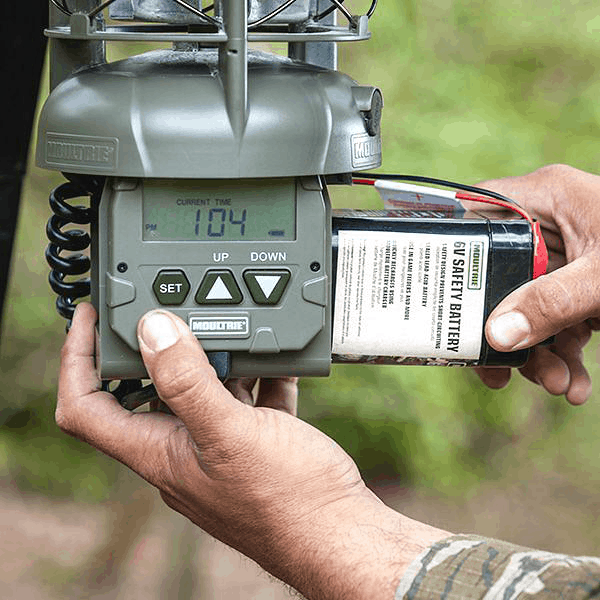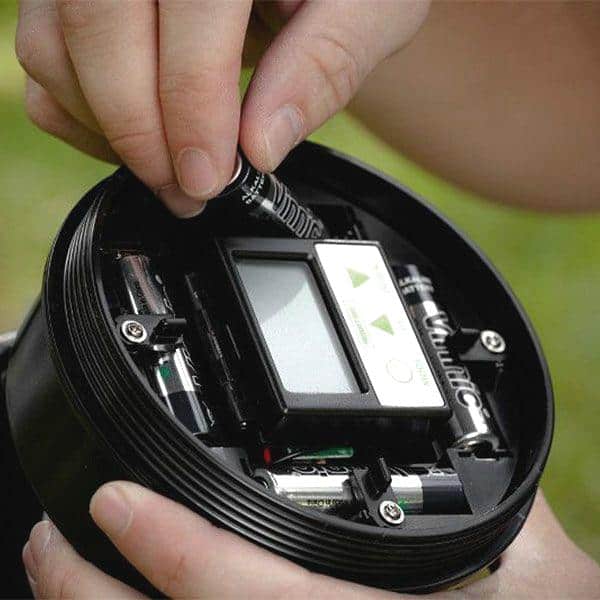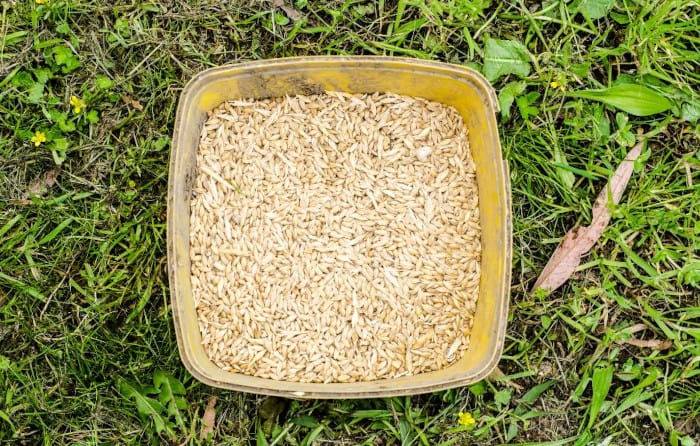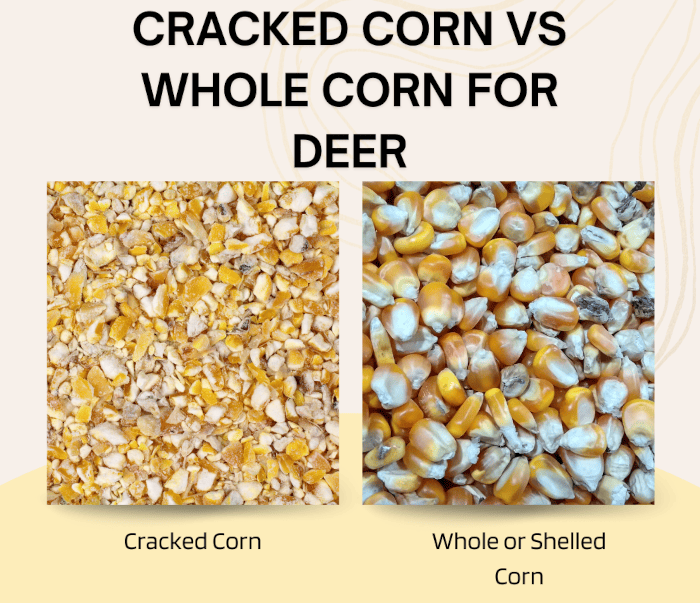When it comes to deer feeders, one of the more commonly asked questions that I see (and am asked at my day job) has to do with deer feeder batteries. When it comes to batteries, the most commonly asked question I see is: how long does a 6 volt battery last in a deer feeder?

I completely understand the how and why of the question, as replacing batteries is one of the most tedious parts of maintaining a deer feeder.
However, trying to accurately answer the question is difficult as the answer depends on several factors, including:
- The feeder brand
- The frequency that the feeder runs per day
- The duration of the feed cycle per feeding
- Type of 6-volt battery
- Number of feeder actions powered by the battery
- Weather
Let’s dive a bit deeper into each sub-topic:
Feeder brand
If you do any research on deer feeders, it won’t take long to figure out there are many different brands on the market. While many different factors play a role in battery life, my experience has been that certain brands offer better battery life than others.
For example, I find that Moultrie feeders and On Time feeders do a decent job with battery life. I will say that Moultrie models seem to perform better with a higher-end, rechargeable 6-volt battery compared to a standard alkaline 6-volt. A cheap no-name alkaline 6-volt won’t last long in a Moultrie feeder.
My experience has been that Wildgame Innovations feeders and Kenco feeders seem to offer the shortest battery life.
The frequency that the feeder runs per day
Except for gravity-based feeders, most hanging, broadcast, and tripod-style feeder models on the market, today are equipped with a programmable timer that allows the user to program the number of times that the feeder activates daily.
These programmable features vary from brand to brand and feeder model to model. Most of the models offer the ability to set the feeder to dispense feed anywhere from two to six times a day.
Since the battery powers the feeder motor, the number of times that the feeder runs per day plays a role in how long the battery charge lasts. A feeder set to run six times a day will usually run the battery down faster than the same feeder set to run twice a day.
The duration of the feed cycle per feeding
Most deer feeders with a programmable feature also have settings to control how long the feeder dispenses food or feed when it activates. Most feeder brands on the market offer this setting in increments of seconds, with most offering the flexibility of distributing feed in a range of 5 seconds to 60 seconds.
In addition to the number of times the feeder activates per day, the duration of each feed cycle also plays a role in battery life on a 6-volt battery.
A feed set to dispense food twice a day with a 60 second feed time will drain more from the battery than the same feeder operating twice a day with a 10 second feed time.
Also, the duration of the feed cycle plays a huge role in the volume of feed being dispensed. In my experience, a feeder set to run for 60 seconds dispenses around 2 pounds of corn or feed. The same feeder set to distribute feed for 10 seconds dispenses about ¼ a pound of feed. Obviously, that number can vary from feeder to feeder.
Type of 6-volt battery
Typically, there are two types of 6 volt batteries that are used in deer feeders:
- Alkaline 6 volt
- Rechargeable 6 volt
Let’s discuss each battery type, along with the pros and cons:
Alkaline 6 volt battery
The alkaline version is the most common of the 6-volt battery models on the market. If the alkaline name is confusing, these are basically disposable batteries that you discard when they run out of power.
Like any other product on the market, there are well-known battery brands and no-name brands. However, I find that the better-known battery brands tend to perform better than the no-name or lesser name brands.
For example, a few years ago, I came across an awesome deal at Costco on a three-pack of off-brand (as in not a name brand) 6 volt alkaline batteries and grabbed a pack for the upcoming season. The fact that the battery package was not dated should have been a red flag, but I was smitten by the price.
When I arrived home, I used a tester to check the power level of each of the batteries. Two were at less than 10%, and one was at 50%. So I returned to Costco and exchanged them for a “new” pack. When I tested the 2nd pack, one battery was 60%, one was 40%, and one was completely dead.
Something else to be aware of with alkaline batteries is their “shelf life.” Most of the better brands of alkaline batteries (not just 6-volt models) have an estimated shelf life that is typically measured in years. The shelf life number starts when the battery is placed on the store shelf for sale. I find the shelf life measurement to be more of an exaggerated estimate versus accurate numbers.
I would suggest sticking with the brand name alkaline batteries and try for ones that have been on the shelf in a store for the shortest amount of time.

Rechargeable 6 volt battery
Much like the name implies, this battery style is a 6-volt rechargeable model. These batteries can be recharged one of two ways:
- Wall charger
- Solar charging panel
While rechargeable batteries tend to cost more than alkaline batteries, they benefit from a significantly longer life compared to the alkaline models, and they tend to be a stronger battery than alkaline models.
If you compare purchase costs to battery life, I find the rechargeable models a much better option cost-wise.
The one obvious downside to rechargeable batteries is the fact that they have to be recharged. Typically, when using rechargeable 6-volt batteries, you have two options:
- Purchase more than one battery, and run swaps each time the battery power runs down.
- Invest in a solar panel that will recharge the battery while it’s in use on the feeder.
I’ve used both approaches and most definitely prefer the solar charging panel option. While the solar charging approach is more expensive, it’s also an easier method as the battery stays charged.
While rechargeable batteries have a longer lifespan than alkaline models, rechargeable models will only hold a charge for so long and will eventually die as well.
Number of feeder actions powered by the battery
Some of the more expensive deer feeder models are equipped with more than one feature that requires power to operate. For example, some models also come with features like:
- A battery power meter
- Integrated game camera
- Shocking capability for pests
The more of these features that require power equates to more energy being drained from the battery.
I had a customer at my day job decide to purchase a top-of-the-line Moultrie feeder with a shocking varmint guard to keep the squirrels and raccoons from pulling feed from the feeder port.
Given the technology that was running on the feeder, I suggested the following:
- Buy the Moultrie rechargeable 6-volt battery and matching Moultrie solar charging panel that the manufacturer specifically suggested for this feeder model.
- Or, purchase a good quality rechargeable battery from a specialized store like Batteries Plus, and consider mating it to a solar panel charger.
He deferred on the Moultrie battery and solar panel that we had in store and indicated that he would purchase a battery separately.
Six weeks later, he was back in the store wanting to return the feeder because it was a “battery hog” and wouldn’t run for more than two weeks without the battery dying.
As we talked through the set-up and tried to troubleshoot the issue verbally, he shared that he was powering the unit with an alkaline 6 volt versus a good rechargeable unit. It turns out that the alkaline battery was the issue as the power drain on it was too much to power the feeder for more than two weeks.
He switched to the Moultrie branded battery and solar combo, and the issue was resolved. Just to clarify here, I’m not advocating that the Moultrie or any other feeder brand of battery as the only solution. I find that Batteries Plus carries some excellent 6-volt rechargeable battery options as well.
Weather
While most people don’t think of the weather as a factor in battery life, extreme heat or cold can and will reduce the life of the average battery (alkaline or rechargeable).
I find that cold seems to be more of a battery drain than heat, but I don’t generally operate deer feeders during the summer months, so my experiences with feeder batteries and extreme heat are limited.
However, I certainly have noticed a correlation between colder temperatures and lower battery life. The colder the temperatures, especially below the 25-degree mark, the faster my feeder batteries run down. When the nighttime (or daytime) temperatures get below 25 degrees, I’ve noticed that feeder batteries seem to run down at least a week faster than they did during milder temperatures.
I’ve got a college buddy who lives and hunts in northern Indiana, which has much colder temperatures than my home state of North Carolina. He’s had such bad experiences with battery issues in the freezing temperatures that he switched all his feeders over to gravity feeders to eliminate the entire battery changing and dead battery issue.
So how long does a 6 volt battery last in a deer feeder?
Now that we’ve gone over all the factors that may play a role in the battery lifespan of a 6-volt deer feeder battery let’s try to answer the question: how long will a 6 volt battery last in a deer feeder?
I typically set my feeders up to run (dispense feed) twice a day for 8 seconds. With those parameters, I usually average the following:
Alkaline 6 volt – A brand new alkaline 6-volt battery with a minimum 90% charge will usually last about three months before the battery has to be replaced.
Rechargeable 6 volt – A good quality rechargeable 6-volt battery will usually last me 4 to 5 months before it has to either be replaced or recharged.
Obviously, with so many variables that play a role in deer feeder battery life, your own battery life experiences may vary.

FAQS
Here are some other commonly asked questions that I see and hear regarding deer feeder batteries:
Will a deer feeder made to run on a 6-volt battery accept a 12-volt battery?
It may, but here are a few potential issues:
Size of the battery compartment – If the battery compartment in the feeder is specifically made for a 6-volt model and doesn’t have any additional room, then the larger 12-volt model won’t fit.
In most cases, running a 12-volt battery in place of a 6 volt model does not cause any issues. However, some feeder brands have a volt sensor that will take the feeder motor offline if it detects any voltage above 6 volts. So you’ll have to place a voltage restrictor in between the battery and the terminal connections or just stick with a 6-volt battery in that situation.
What size battery for my deer feeder?
From a battery standpoint, deer feeders are not universal and do not all accept the same size battery. The battery size can vary from:
- AA-size
- C size
- 6 volt
- 12 volt
- Battery Packs – which are a specially made pack that is loaded with a specific battery size. For example, a C pack will be a battery carrier designed to carry 4 C size batteries.
Although I try to keep all my feeders on the same battery size, I’ve had situations where I ended up with feeders running different batteries. For example, at one point, I had to bring spare AA’s, C batteries, and 6-volt batteries to one property I leased because I had a hodge-podge of feeder brands and styles operating on the property.
I would suggest reading the specific specifications of any deer feeder you are considering, as the specification should clearly identify the necessary battery size.
How much does a 6-volt battery for a deer feeder weigh?
Alkaline 6-volt batteries generally weigh around 1.2 pounds, while rechargeable 6-volt battery models are usually a little bit heavier, weighing anywhere from 1.5 to 2 pounds.
As I come across more questions about deer feeder batteries, I’ll update this page.





